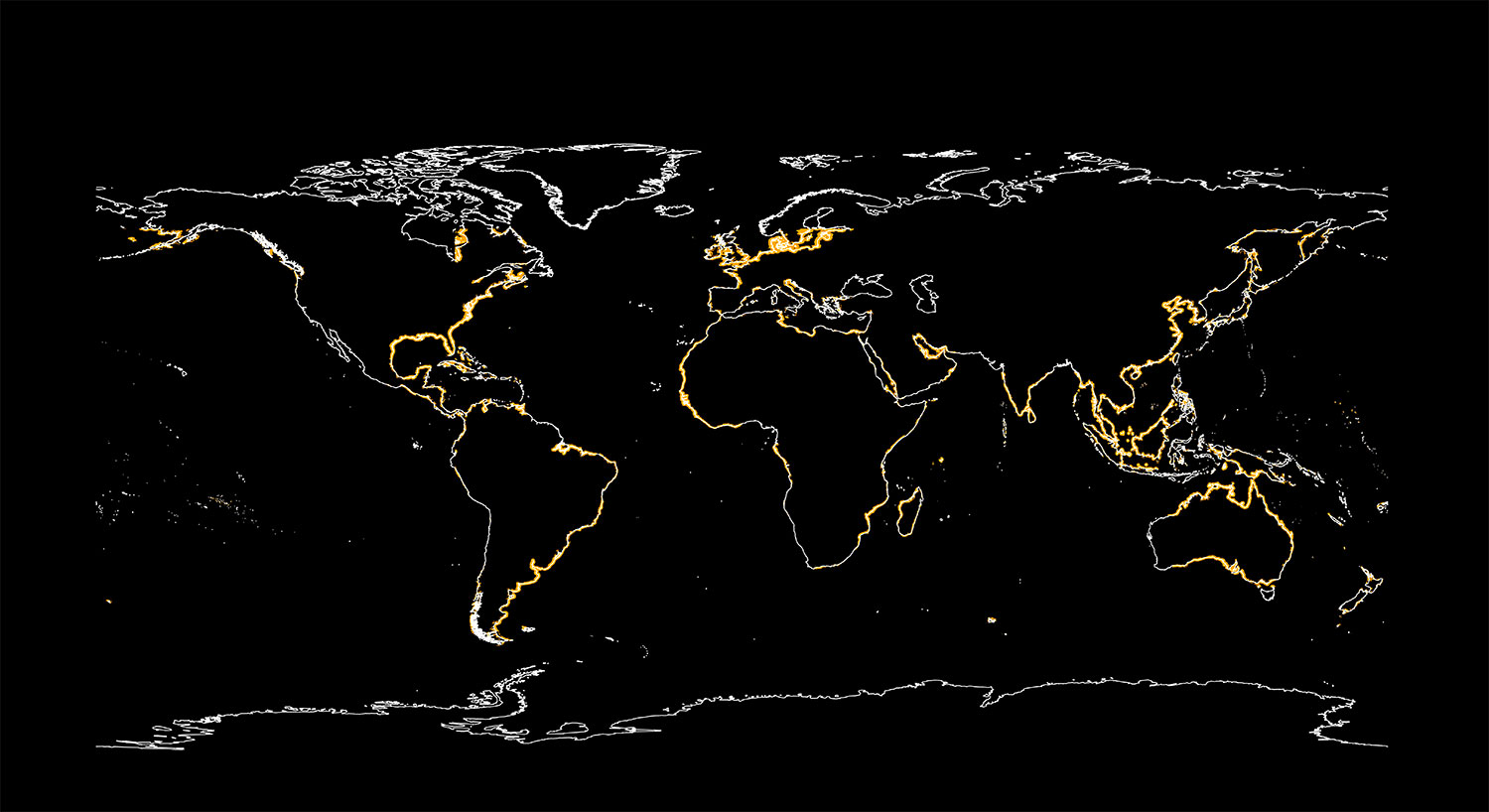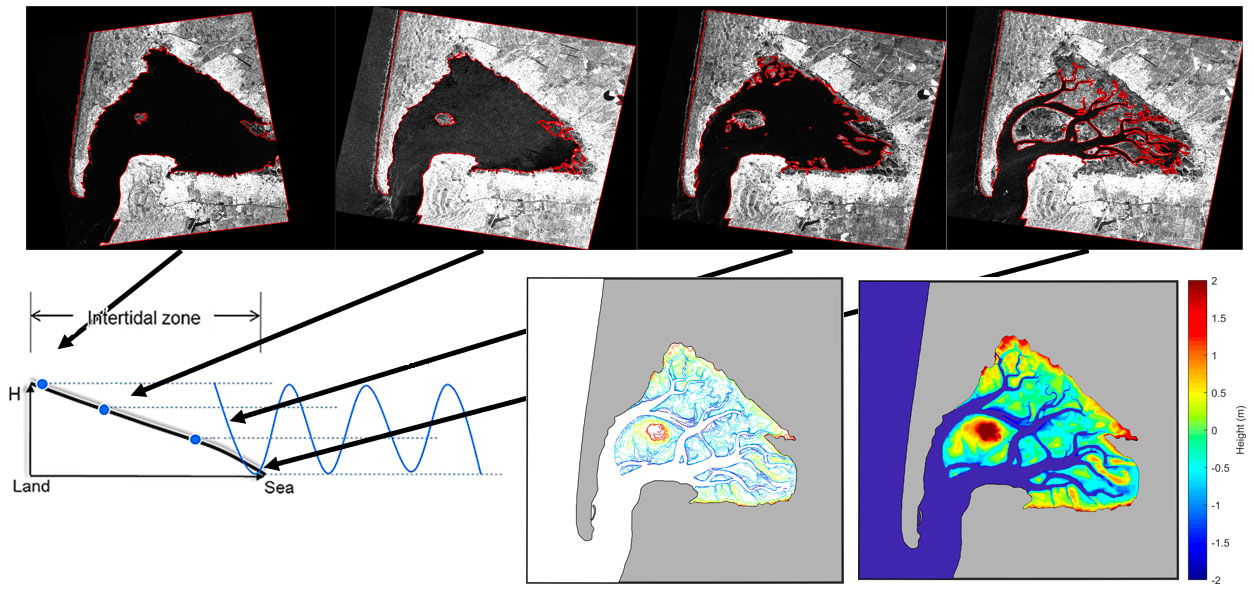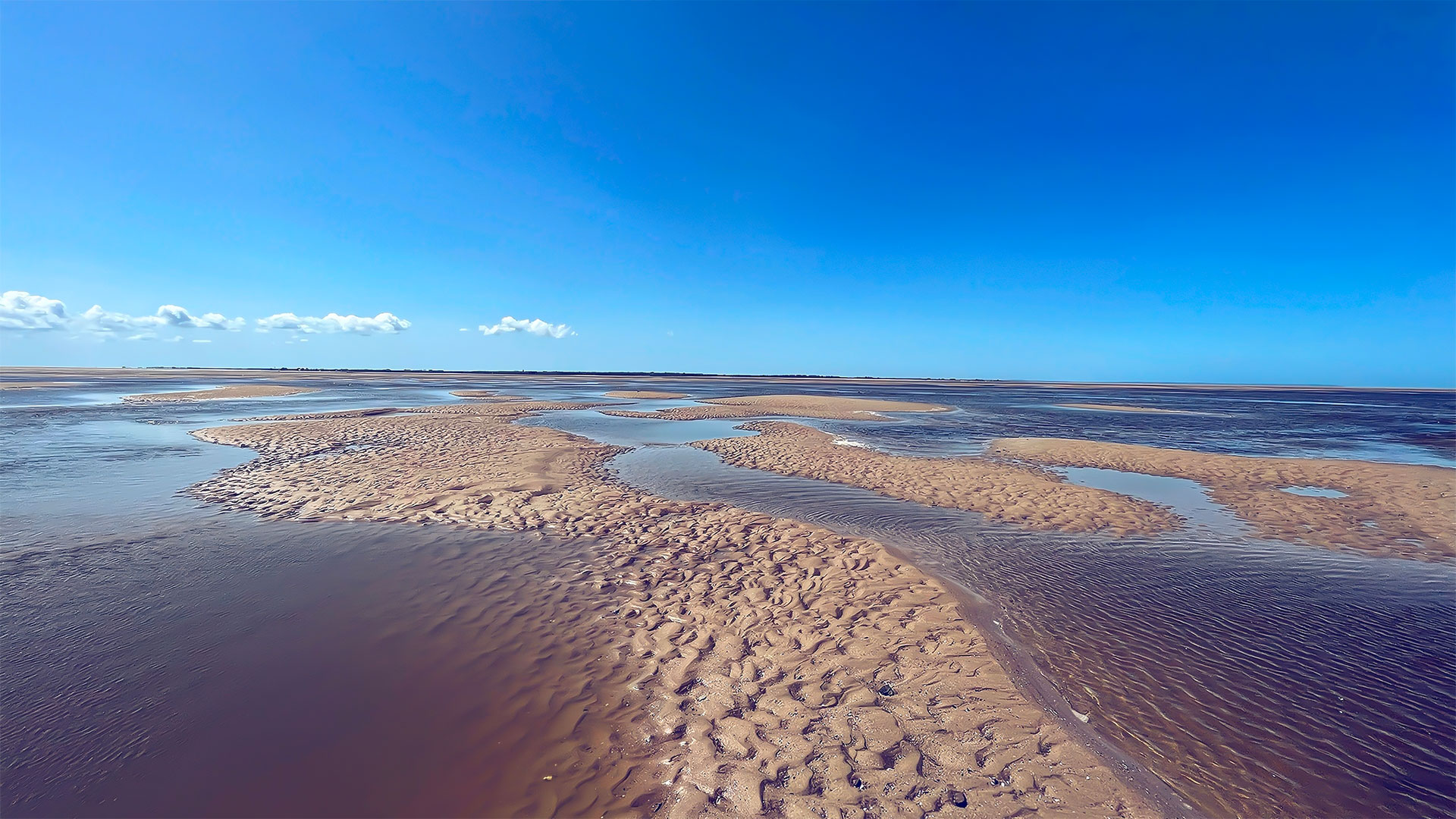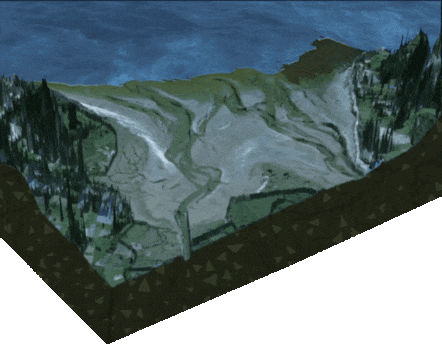EO4Intertopo
Observation of changes in the topography of coastal intertidal zones from space in the context of climate change
|
◀︎ 3D animation of the Baie des Veys in Normandy: between the flow of high tides and the retreat of low tides. © CNRS/Edward Salameh |
|
Overview
Context
Coastal regions are increasingly vulnerable due to the effects of climate change. It has become imperative to put in place effective coastal management strategies to mitigate these risks and protect coastal communities and ecosystems. Intertidal zones, located at the interface between land and sea, are one of the most important natural buffer zones for the protection of coastal regions. These zones cover around 127,000 km2 worldwide (Murray et al. 2019) (Figure 1). They are highly productive areas characterized by high biodiversity and provide natural protection against storms and coastal flooding (Murray et al. 2019). Human interventions (coastal development, dredging, upstream dams, pollution, etc.) have put these environments under severe pressure. A recent study by Murray et al. (2019) showed that the world's intertidal zones decreased in area by 16% between 1984 and 2016. Reduced sediment supply from rivers, subsidence of deltas, increased coastal erosion and sea level rise are leading to a continued negative trajectory for these ecosystems worldwide. What's more, these environments appear to be particularly vulnerable to the current rise in sea level and its future acceleration, as well as to the intensification of storms. In response to these various oceanographic and hydrological processes, intertidal ecosystems are highly dynamic. Monitoring the dynamics of intertidal zones is therefore crucial for implementing sustainable coastal defense measures and preserving ecological habitats.

Figure 1. Global distribution of intertidal zones (orange) © Murray et al., 2019/Edward Salameh
Normandy is located in a macrotidal to megatidal environment that is particularly difficult to monitor, with wide variations in water levels (a tidal range that can exceed 10 meters and more, as in the Bay of Mont-Saint-Michel, for example, where it can rise to 15 m in the event of a very high tidal range). In Normandy, intertidal environments are a major coastal environment with major economic and social implications for the region. A range of economic activities (e.g. fishing and oyster farming, shellfish farming, port development, etc.) and tourism rely on these complex and threatened systems (e.g. Mont Saint Michel Bay, Seine Estuary).
Objectives
EO4Intertopo is a project that exploits satellite data, in particular optical and radar imagery, to provide accurate mapping and monitoring of intertidal zones along the Normandy coast. By studying morphological changes in these areas, the project aims to support informed decision-making and facilitate proactive coastal management practices for a resilient and sustainable future.
The main objectives of this project are to
-
Complete mapping of intertidal topography and substrate (e.g. mud, sand, pebbles, rocks, etc.), and changes in topography for the entire Normandy coast using satellite data (optical, microwave and laser sensors on Earth observation satellites);
-
Identification of the evolution of intertidal zones (erosion-accumulation) in relation to current forcings and the possible consequences of climate change (rising sea levels and storms);
-
Generation of products based on satellite data to be used as awareness-raising and decision-making tools for local stakeholders.
Methodology
Measuring intertidal topography from space is commonly carried out using the waterline method (Figure 2) proposed by Mason et al. (1995). Since then, various approaches to applying this method have been put in place, such as the method developed and published by Salameh et al. (2020). This method uses multispectral imagery as well as radar imagery. As they are not affected by cloud cover, radar sensors (e.g. Sentinel-1) significantly improve temporal sampling, making it possible to provide more accurate DEMs (digital elevation models). The processing will be based on the work of Salameh et al (2019, 2020, 2021) where a methodological development has been implemented for the monitoring of two intertidal bays: the Arcachon Basin and the Bay of Veys in Normandy.

Figure 2. Diagram illustrating the water line method © Salameh et al. (2020)
Application site(s)
The entire coastline of the Normandy region, France
Data
Satellite
- Sentinel-1
- Sentinel-2
- Landsat series
- Pleiades
- Icesat-2
- SWOT
Modelled data and in-situ observations
- Outputs from the Hycom hydrodynamic model supplied by SHOM (Water level + Surge)
- The FES tidal model (LEGOS)
- Observations made by tide gauges along the Normandy coast
- Aerial lidar observations (recurring topo-bathymetric and orthophotographic data from the ROL (Coastal Observation Network, Réseau d'Observation du Littoral), covering the whole of the Normandy and Hauts de France coastline, including the foreshore at low tide during spring tide).
Results - Final product(s)
The aim of the project is to provide stakeholders and researchers working in coastal environments with accurate intertidal topographic data covering a vast area and software for automatically generating intertidal topographic maps from satellite data, to ensure continuity of observations.
The project will include the following elements:
-
The delineation of Normandy's intertidal zones based on satellite data, in the form of shapefile files;
-
Annual topographic maps (from 2016 to 2025) of Normandy's intertidal zones, essential for modelling coastal hydrodynamics and monitoring morpho-sedimentation in coastal areas;
-
Maps of inter-annual erosion and accretion (+ sediment budget), and therefore identification of areas prone to erosion;
-
The algorithms developed and used, along with the data produced, will be made available to local stakeholders, along with documentation and user guides, via the digital atlas of the Normandy and Hauts-de-France Coastal Observation Network platform and the multi-hazard digital platform of the T.URN Institute for Transitions at the University of Rouen Normandy.
References
 |
EO4Intertopo on GEO Knowledge Hub, a long lasting digital repository created by the Group on Earth Observations: https://doi.org/10.60566/rw2r0-t3e43 |
-
Salameh, E., Desroches, D., Deloffre, J., Fjørtoft, R., Mendoza, E. T., Turki, I., Froideval, L., Levaillant, R., Déchamps, S., Picot, N., Laignel, B., Frappart, F. (2024). Evaluating SWOT's interferometric capabilities for mapping intertidal topography. Remote Sensing of Environment, 314, 114401.
-
Salameh, E., Frappart, F., Desroches, D., Turki, I., Carbonne, D., & Laignel, B. (2021). Monitoring intertidal topography using the future SWOT (Surface Water and Ocean Topography) mission. Remote Sensing Applications: Society and Environment, 23.
-
Salameh, E., Frappart, F., Turki, I., & Laignel, B. (2020). Intertidal topography mapping using the waterline method from Sentinel-1 & -2 images: The examples of Arcachon and Veys Bays in France. ISPRS Journal of Photogrammetry and Remote Sensing, 163.
-
Murray, N. J., Phinn, S. R., DeWitt, M., Ferrari, R., Johnston, R., Lyons, M. B., Clinton, N., Thau, D., & Fuller, R. A. (2019). The global distribution and trajectory of tidal flats. Nature, 565(7738), 222–225.
-
Salameh, E., Frappart, F., Almar, R., Baptista, P., Heygster, G., Lubac, B., Raucoules, D., Almeida, L. P., Bergsma, E. W. J., Capo, S., de Michele, M. D., Idier, D., Li, Z., Marieu, V., Poupardin, A., Silva, P. A., Turki, I., & Laignel, B. (2019). Monitoring Beach Topography and Nearshore Bathymetry Using Spaceborne Remote Sensing: A Review. Remote Sensing, 11(19).
-
Mason, D. C., Davenport, I. J., Robinson, G. J., Flather, R. A., & Mccartney, B. S. (1995). Construction of an inter-tidal digital elevation model by the “water-line” method. Geophysical Research Letters, 22(23), 3187–3190.
Related project(s)
SCOast-DT, Coastal Zone Digital Twin
Project news
-
🎥 27/03/2025: Presentation of the Xoxox project and its progress at the 16th SCO France Quarterly Meeting "Coastal ranges: issues and solutions"
- 12/11/2024: EO4InterTopo automates intertidal topographic mapping









